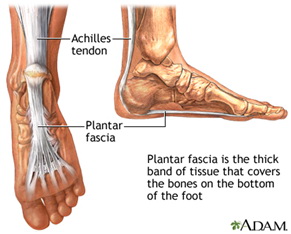Gentle Reader,
Has this happened to you?
You make a goal to step up your fitness training to prepare for a back packing trip. Maybe, like me, you have a big hike in your future and your friends are suggesting that you need to train harder for it. After all, the Alps are high mountains. You start at 5000 ft and go up from there. You say you’re just going to be in the North Cascades. Maybe you just want to do the 3 day walk for the Cure next time it comes to town.
You double your effort. Instead of walking 3 – 4 miles 3 times a week, I increased to daily walks of that length.
Within 10 days of the increase, I felt a twinge in my heel and a shooting pain up my calf. I recognized this sensation right away because years ago I had a similar experience, ignored it for 6 months. Major interventions were necessary. I had to abandon my favorite form of exercise, running. Not good.
To save you the trouble, I have condensed information from excellent resources.
What is plantar fasciitis?
Plantar fasciitis is inflammation of the thick tissue on the bottom of the foot. This tissue is called the plantar fascia. It connects the heel bone to the toes and creates the arch of the foot.
What causes plantar fasciitis?
Plantar fasciitis occurs when the thick band of tissue on the bottom of the foot is overstretched or overused. This can be painful and make walking more difficult.
You are more likely to get plantar fasciitis if you have:
- Foot arch problems (both flat feet and high arches)
- Long-distance running, especially running downhill or on uneven surfaces
- Sudden weight gain or obesity
- Tight Achilles tendon (the tendon connecting the calf muscles to the heel)
- Shoes with poor arch support or soft soles
Plantar fasciitis is the most common orthopedic complaint relating to the foot that affects people over 40, men and women alike.
Check out the reference for symptoms and description of the pain.
I will cut to the chase and give you those tricks to moving past this problem quickly:
1. Stop doing what hurts. I cancelled out of a training hike to Pratt Lake, an elevation gain of 2300 ft in 8 ½ miles along a beautifully maintained trail in old growth cedar, hemlock and fir in the Snoqualmie pass area, already snow free while many high places still have snow on the trail. Perhaps you are like me and have a really hard time cancelling activities like this. Do it anyway. Be proud of yourself for listening to your body. Stop doing what hurts.
2. Ice the heel. 15 minutes on, 15 minutes off.
3. Take an anti-inflammatory if needed. Personally, I only hurt when I am walking a couple of miles, about 20 – 30 minutes into the walk. I can manage the pain with Shaklee’s Pain Relief tablets, but this isn’t about managing pain, this is about calming the irritation, reducing swelling, getting back to healthy facia.
4. Stretch the Achilles tendon and heel. I use a strap, lie on my back and push into the strap with my foot perpendicular to the floor. It actually hurts like hell so I know I need to do this more than I do. Peggy Cappy’s yoga for back pain relief gets me stretching longer with greater benefit. Here’s an excellent 1 minute video for healing Achilles tendon injuries.
5. Cross train to keep up your fitness level. I dusted off my bike and filled the tires and sailed down to the beach on Alki from the top of Genesee Hill. The challenge was coming back up and I made it without having to walk by going around the long, slow, gradual way. You can swim, too. Anything that takes the pressure off the arch.
6. Be patient with your body. Perhaps this is the hardest of all. On the plus side, when you are on a bike, you can cover more ground, see more of the beautiful area you live in. The lake or river near you is pleasant this time of year. Go for it. No thumb sucking, pity me. I’m talking to myself here. I love the efficiency of walking for exercise. It takes more planning to bike or swim, a bigger chunk out of the day. Just do it or you might lose all that ground you’ve been gaining with your walking program.
7. Prevent this happening to you in the first place.
a. Don’t suddenly change your routine without stretching more as well.
b. Keep the Achilles tendon and heel flexible.
c. Wear good supportive firm-heeled shoes whenever you walk or run.
d. Get a pair of orthotic inserts for great arch support.
Take action! Begin these exercises today.
Like this information? Sign up to get more tips of how to Be Well and Keep Moving each week.
Please, take a minute to let me know what you have done about Achilles tendon troubles. You know, your best orthotic, your most effective exercise, the way you handled a temporary set back. We’ll all benefit from your experience.
Fondly, Betsy
Be Well, Do Well and Keep Moving
BetsyBell’s Health4u
206 933 1889 1 888 283 2077
betsy@hihohealth.com
